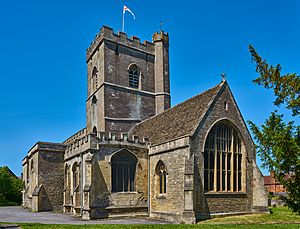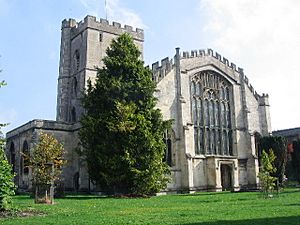All Saints' Church, Westbury facts for kids
Quick facts for kids All Saints' Church, Westbury |
|
|---|---|

All Saints' from the south-east in May 2020
|
|
| Lua error in Module:Location_map at line 420: attempt to index field 'wikibase' (a nil value). | |
| Location | Westbury, Wiltshire |
| Country | England |
| Denomination | Anglican |
| Architecture | |
| Functional status | Parish church |
| Style | Decorated Gothic, Perpendicular Gothic |
| Years built | 1340–c.1550 |
| Specifications | |
| Tower height | 84 ft (26m) |
| Bells | 8 |
| Tenor bell weight | 35cwt-0qrs-14lbs in C# |
| Administration | |
| Parish | Westbury |
| Deanery | Heytesbury |
| Archdeaconry | Sarum |
| Diocese | Salisbury |
| Province | Canterbury |
The Church of All Saints is a very old and important church in Westbury, Wiltshire, England. People have worshipped here since Saxon times, which was a very long time ago! The church you see today was mostly rebuilt around 1437. It's so special that it's a 'Grade I listed building,' meaning it's protected because of its history and beauty.
Contents
History of the Church
How Old is All Saints' Church?
There has been a church on this spot since at least 1086. This was recorded in the Domesday Book, which was a big survey of England ordered by William the Conqueror. The very first church here was probably made of wood during the Saxon period.
Around 1220, the Normans built the first stone church on this site. Later, in the 1300s, a new Gothic-style church was built. It followed the same layout as the Norman church.
Building the Church We See Today
The Gothic church was built between about 1340 and 1380. You can still see parts of this older building in the church today. Look for them in the lower parts of the transepts (the arms of the cross-shaped church) and the nave (the main part where people sit). The lower part of the tower is also from this time.
Around 1437, the church was made much bigger and taller.
- A clerestory was added to the nave. This is a row of windows high up on the walls, letting in more light.
- Three new chapels were built.
- The central tower was made taller, reaching 84 feet (26 metres) high.
In the mid-1500s, a south porch (an entrance area) was added, with a small room above it. The chancel (the part of the church near the altar) was also made longer.
Keeping the Church Strong
By 1847, the church needed a lot of repair work. A new roof was put on the nave, and a large window was added at the west end. A small vestry (a room for the clergy) was also created.
In 1968, engineers found that the church was becoming unsafe. An old underground drain had broken, and water was soaking the ground under the church's foundations. Cracks started to appear in the stone walls, and the tower was leaning! To fix this, 150 strong concrete poles were pushed deep into the ground. These poles were connected with new beams to make the building stable again.
The famous architectural expert, Nikolaus Pevsner, said that All Saints' Church looks similar to Edington Priory, another old building nearby. He thought the west front (the main entrance side) was "remarkable" because of its unique shape.
Church Bells
The Heavy Bells of Westbury
The central tower of All Saints' Church has a special rectangular shape. Inside, it holds a set of eight bells that are used for change ringing. These bells are the third heaviest set of eight bells in the world! Only Sherborne Abbey in Dorset, England, and St Peter's Cathedral, Adelaide in Australia have heavier sets. Because they are so special, many bell-ringers from other places love to visit and ring them.
Before 1921, the tower had six bells. These bells were made by different people between 1671 and 1738. In 1921, a company called John Taylor & Co was asked to fix the bells. The plan was to add two new bells and fix the old ones. However, when the old bells were taken to the factory, it was found that they couldn't be properly fixed. So, the company made eight brand new bells, which are the ones in the tower today. The largest bell, called the tenor, weighs about 35 long hundredweight (which is very heavy!) and rings the note C#.
The church also has two other old bells:
- A small bell from around 1299, called a sanctus bell.
- An unused bell from about 1600, which hangs in an old wooden frame above the main set of eight bells.
Monuments and Memorials
Inside the church, you can see a sculpture of William Phipps (1681–1748). He was born nearby and later became the Governor of Bombay.
In the churchyard (the area around the church), there are several old stone tombs from the 1700s and early 1800s. To the south-east of the chancel, there is a tall stone cross. This is the parish war memorial, built around 1919 or 1920, to remember those who served.
The Church Parish
How the Parish Changed Over Time
A parish is the area that a church serves. The old parish of Westbury used to be very large, stretching east to Bratton and west to Dilton. Both of these areas had smaller churches that were connected to Westbury.
- In 1845, Bratton got its own separate church district.
- The old St Mary's church at Dilton became less used, especially after a new church, Holy Trinity, was built in Dilton Marsh in 1844. Dilton Marsh also got its own district in 1845. St Mary's Church stopped being used regularly in 1900. Today, it is looked after by the Churches Conservation Trust, which helps protect old churches.
- In the north, after Holy Trinity church was built in Heywood in 1849, that area also became its own separate district.
- To the south-west, at Westbury Leigh, the Church of the Holy Saviour was built in 1877 as a smaller church for the local community. It was made bigger in 1889–90.
Today, All Saints' Church is the main church in the "White Horse benefice." This group includes the old and new Dilton churches, Holy Saviour, and a small church built in 1905 at Brokerswood.
Images for kids




